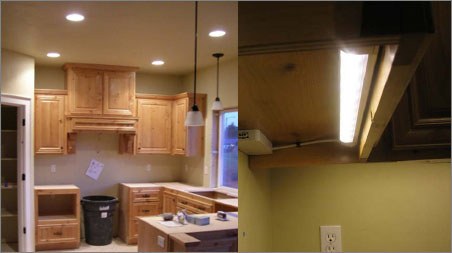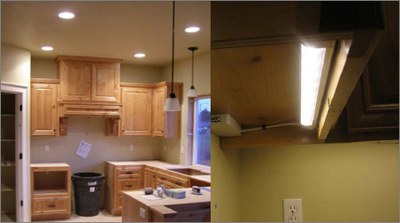DOE Report on Residential LED Lighting Shows Advantage over Conventional Lighting
In August 2008 the Pacific Northwest National Laboratory (PNNL) conducted a light-emitting diode (LED) residential lighting demonstration project for the U.S. Department of Energy (DOE), Office of Building Technologies, as part of DOE’s Solid-State Lighting (SSL) Technology Demonstration GATEWAY Program. Two lighting technologies, an LED replacement for lamps (bulbs) in downlights and an LED undercabinet lighting fixture, were evaluated in the demonstration which was conducted in two homes built for the 2008 Tour of Homes in Eugene, Oregon. The homes were built by the Lane County Home Builders Association (HBA) and Future B Homes. The Energy Trust of Oregon (ETO) also participated in the demonstration project.
Quantitative and qualitative measurements of light performance and electrical power usage were taken at each site before and after initially installed halogen and incandescent lamps were replaced with the LED products. Energy savings and simple paybacks were calculated and builders who toured the homes were surveyed for their responses to the LED products.
The LED downlight product drew 12 Watts of power, reducing energy use by 82% compared to a 65W incandescent reflector lamp and by 84% compared to a 75W halogen reflector lamp. The LED undercabinet fixture drew 10 watts, cutting energy use by 83% to 90% compared to a halogen product, which was tested at two power settings – a low power setting that drew 60 watts and a high power setting that drew 105 watts.
The measured color correlated temperature (CCT) of the LED downlights correlated well with the CCT of the halogen and incandescent lights (2675 K vs. 2700 K). The color rendering of the LED downlight also correlated well at 92 CRI compared to 100 CRI for the halogen and incandescent lamps. The LED undercabinet fixture had measures of 2880 K CCT and 71 CRI compared to the 2700 K and 100 CRI scores for the halogen undercabinet fixture.
Builders who toured the homes were asked to complete a written survey regarding their perceptions of the light quality. They gave the LED downlight high marks for brightness and most felt the LEDs were the same as or an improvement over the halogen and incandescent lamps in terms of shadows and glare. The majority gave the LED products high marks for overall visibility and improvement in home appearance and surprisingly a high number said they felt the LED products improved the homes’ value (83% said this about the downlight and 75% said this about the undercabinet fixture).
The dimming performance of the LED downlight product was also evaluated because LEDs are anticipated to have better dimming capability than other high-efficiency downlight alternatives, namely CFL R-lamps. It was difficult to find the brands of dimmers that were identified by the LED downlight manufacturer as compatible with its product, however. The lamp was tested with a non-compatible dimmer and was found to be difficult to set below 50%. The lamps either didn’t dim enough or turned off and they did not operate in unison. According to the builder, a compatible dimmer was found after PNNL’s testing, and it is functioning satisfactorily. LED dimmer compatibility is an area for further manufacturer support and industry action.
Paybacks on the LED downlights ranged from 7.6 years (assuming electricity cost of 11 c/kWh) to 13.5 years (at 5c/kWh)a based on product costs of $95 per LED downlight and 3 hrs per day of usage. Paybacks on the LED undercabinet fixture in a new home ranged from 4.4 years (11c/kWh electricity) to 7.6 years (5c/kWh) based on product costs of $140 per LED undercabinet fixture at 2 hrs per day of usage. These payback calculations do not take into account labor costs to replace burned out bulbs or fixtures, which are expected to occur much more frequently with halogen and incandescent lamps than with LED products. Paybacks will be shorter if lamps are operated more hours per day, if electricity prices go up, and/or if the initial purchase price goes down for the LED products. These products have been commercially available for less than a year; prices are expected to drop as the technology improves, as component costs decrease, and as sales and competition increase.
Tis and additional LED reports are available for download at www.netl.doe.gov/ssl.
Download report: Residential LED Lighting Demonstration


